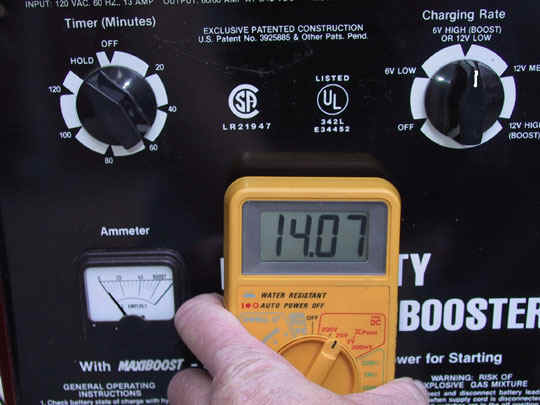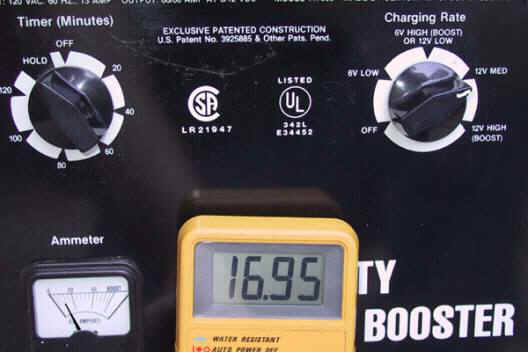|
Part 2,
RECHARGING A DISCHARGED BATTERY

With the charge rate selector increased to HIGH,
the charger is delivering a 40 amp current flow to the
battery and voltage at the battery rises to 14.2volts.
This is the rate that a powerful alternator would
recharge a powerful model battery, at peak charge rate.
But in the car, the voltage regulator would limit
system voltage to about 14.2volts, the amps would taper
off as the battery became charged.
With
our charger, voltage level soon came up and surpassed
15volts at this charger setting, because the battery did
not want this much current.
Expect that with this large charger set to HIGH
rate, the battery will soon begin to produce a lot of gas
from the vents. And
the battery temperature may rise to warmer than acceptable
level. This
charger does not limit voltage to the 14.2volts as a
regulator for an alternator would, and so voltage will
soon climb above acceptable level.
It’s
actually difficult to fully charge a battery at
excessively high charge rates. (It doesn’t give opportunity for chemical reaction in the
battery to fully pentrate the plates.
(We shut it down just after this photo was taken.)

We have again connected the small 6amp charger, and
let it charge the battery for a few hours.
Now as the battery begins to recover, it is
accepting less current (about 3 1/4amps).
Also as the battery is becoming charged, voltage
has come up to 13.8volts.
In a previous photo at “Part 1” showing this
small charger, the battery was at a less charged
condition, and the battery was accepting over 4 amps with
voltage at 13.1volts.
Comparison of
the above photo to the previous photo shows that; as
the battery becomes charged, the AMPS are lower, and
the VOLTS are higher.

And
after a couple more hours with the small charger
connected, the battery is only accepting 2amps from the
6amp charger. And
battery voltage is now up to 14.1volts. The battery is approaching a fully charged condition.
Compare
this photo to the previous photo, to see again that as
the battery becomes charged; the AMPS are lower, and
the VOLTS are higher.

Results with the large charger are about the same
as with the small charger, now that the battery is
approaching a fully charged condition. In the photo above, the “Charging Rate” switch is
set to “LOW 12volts.”
The amp gauge on the charger indicates a very small
current flow to the battery, and voltage is at almost
14.1volts.
These readings are about what we would find when
testing an alternator-voltage regulator-battery system,
with battery near fully charged and with normal
alternator-voltage regulator function.

And
here we have set the switch to “12volt MEDIUM” charge
rate, and this photo was taken after about one minute at
this setting. But
as the battery already charged, it does not want this much
current (about 10 amps shown), battery voltage is nearly 17volts,
which is excessive.
If
this were a test of an alternator-regulator-battery
system, an overcharge problem caused by lack of voltage
regulator control would be indicated.
The probable cause would be a defective voltage
regulator.
The 12V
HIGH (BOOST) switch setting would increase the voltage to
a very abusive level—we did not bother to show it.
TYPICAL
OBSERVATIONS WHILE RECHARGING A BATTERY
When the battery is fully charged, it
does not accept much current if the voltage is limited at
14.0 to 14.5volt level.
Therefore, expect that when current at the battery
charger gauge is down to a couple of amps, and battery
voltage is above 14volts, the battery has reached about
full charged condition.
(The
“textbook” level for voltage regulator setting with
most alternator systems is 14.2 volts.
And so expect very low current flow to the battery,
when driving with a fully charged battery.)
- When
recharging a discharged battery, the amps will be high
and the voltage will be a little low.
- As
the battery regains charge, the amps go down and the
voltage comes up.
- When
the battery approaches a fully charged condition, the
amps will be very low if battery voltage is limited to
the 14.0 to 14.5 volt range.
NOTES
Expect
that re-charging at high rate is abusive to batteries.
High rate charging will cause excessive gassing
from vents, and batteries can be overheated too.
(Generally battery temperature should not exceed
125degrees F when re-charging batteries.)
Although it does take longer to re-charge a low
battery with a reduced rate, slow rate re-charging is
generally the least abusive to batteries.

If the battery has removable covers, it should
always be tested with a hydrometer before recharging is
attempted. At
least use the small, inexpensive hydrometer, which can be
found at most Auto Parts stores.
The one shown in the photos above and below has
four small “float balls” of different colors.

- All
four of the balls floating at the top of the liquid
means that the battery is fully charged.
- Three
balls floating and with one ball that sinks indicates
a three-quarter charge condition.
- And
with two balls floating, and two sinking to the bottom
of the liquid, the battery is only at about half
charged condition.
When
working with batteries that have removable covers, there
is a lot of worth to testing a “questionable” battery
with these simple hydrometers.
There are larger, more expensive battery
hydrometers that actually measure specific gravity of the
liquid in the battery.
And the better of hydrometers will also have a
built in thermometer, as temperature affects the reading.
But for most people, the simple inexpensive model
with four “float balls” is fine.
If all the cells show a fully charged condition,
then there is no need to charge the battery; and in some
cases it is dangerous to do so.
And
the hydrometer should verify that all cells are about the
same.
A
defective battery is indicated when the hydrometer test
shows one or more cells “dead” and other cells test at
full charge.
(The hydrometer test is not valid if water has just
been added, and also not valid if the battery has been
charging at high rate, just prior to the test.)
When the hydrometer indicates a fully charged
condition at all cells, then the battery should put out
sufficient power to crank the engine—otherwise the
battery is defective.
When a battery does not have removable covers, then
it is best to observe voltage and amperage while charging,
as we have in the photos with this feature.
TIPS
We have left the removable covers in place while
recharging the battery.
The covers are vented, and they serve as functional
spark arrestors.
When the covers have been removed, any spark near
the top of the battery may directly enter the battery
where there is a high concentration of explosive gas.
And it’s easy to make a spark by touching a metal
tool between the POSITIVE battery post and metal part of
the car.
We
do remove the caps to check liquid level before recharging
a battery.
Also use a HYDROMETER to check the state of charge
condition.
BATTERIES WITHOUT
REMOVABLE COVERS
If a battery does not have sufficient power to
crank an engine, and also does not accept significant
charging current while keeping the voltage within
acceptable levels, then the battery is probably defective
and it should be replaced.
IMPORTANT!
Also
note that when a charger is first connected to a
completely discharged battery, at first the charger is
likely to show only a very low charge rate.
If the amp gauge on the battery shows a low reading
when the charger is first connected, check it again after
about a fifteen minute period of charging.
By then the charge rate will be nearly at peak
amount of current.
And,
some of the best battery chargers are polarity protected.
(ours is not)
Polarity protected chargers will require some
voltage at the battery before charging will begin.
When this type of charger is connected to a
completely discharged battery, a special procedure will be
required.
With the charger connected to the discharged
battery, and the charger switched ON, connect booster
cables from another battery to the discharged battery.
The booster cables must be connected for at least a
few seconds, voltage from the charged battery will
“close contacts” in the charger so that the charger
can go to work recharging the discharged battery.
KEEP
SAFE!
It’s
best not to push our luck around batteries.
Battery explosions are very violent and very
dangerous.
Fast rate charging will generate excessive amounts
of explosive gas.
Have patience and keep the charge rate low when
recharging batteries.
It’s a lot safer; it’s less abusive to the
battery; it causes less corrosion; and the slow rate
charging more thoroughly charges the battery.


|